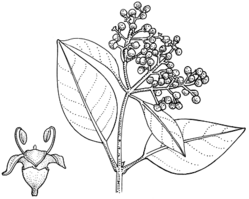Common Name: Privet

Description: Much-branched shrubs or small trees, glabrous or the young growth pubescent.
Leaves opposite, simple, margins entire; petiolate.
Inflorescences terminal panicles. Flowers bisexual, fragrant. Calyx tubular, 4-toothed. Corolla funnel-shaped, 4 lobed, spreading, white. Stamens 2. Ovary 2-locular, 2 ovules per loculus.
Fruit drupaceous; seeds usually 2 or 1 by abortion.
Distribution and occurrence: World: 40–50 species, Mediterranean, Malesia. Australia: 4 species (1 species endemic, 3 species naturalized), Qld, N.S.W., S.A., Tas.
Fruit and leaves of L. lucidum are suspected of being poisonous to stock and small children. Pollen has also been noted to cause an allergic reaction. Ligustrum ovalifolium (Japanese Privet) has been naturalised in WA and Victoria, but so far not in NSW. It looks very similar to both L. sinense and L. vulgare. Ligustrum ovalifolium has bigger fruits (> 8 mm diameter) and longer sepals (> 2 mm long).
Text by D. W. Hardin; updated Peter Jobson Oct 2024
Taxon concept:
| | Key to the species | |
| 1 | Leaves with lamina usually 6–12 cm long, 3–5 cm wide; petioles 10–20 mm long; panicles more than 15 cm long | Ligustrum lucidum |
| Leaves with lamina mostly 3–6 cm long, 1–2.5 cm wide; petioles 1–7 mm long; panicles less than 15 cm long | 2 |
| 2 | Leaves pubescent at least on the midrib on the lower surface, branchlets pubescent; petioles 3–7 mm long | Ligustrum sinense |
| Leaves and branchlets glabrous; petioles 1–3 mm long
Back to 1 | Ligustrum vulgare |
|


